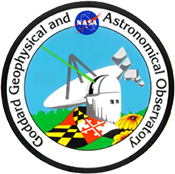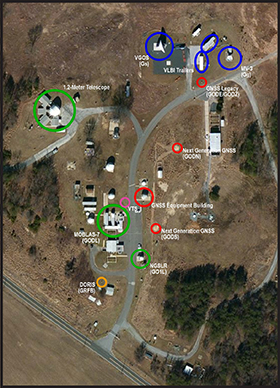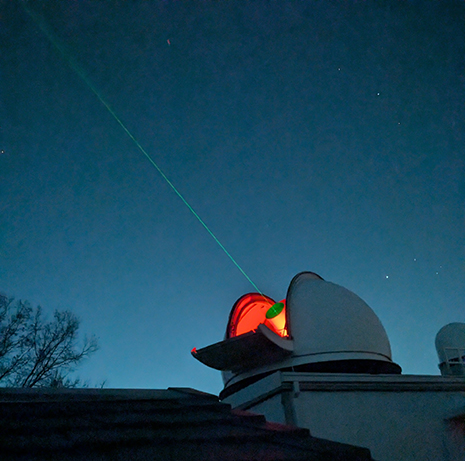Goddard Geophysical and Astronomical Observatory (GGAO)


The Goddard Geophysical and Astronomical Observatory (GGAO) is one of the few sites in the world to have all four geodetic techniques co-located at a single location: SLR, VLBI, GNSS, and DORIS. Thus, sites like GGAO provide scientists a unique opportunity to assess system performance and perform multi-technique analysis. Furthermore, co-located techniques are an integral part to the maintenance of the International Terrestrial Reference Frame (ITRF), a set of points with their 3-dimensional cartesian coordinates which realize an ideal reference system. Co-location of systems in near proximity also enable (according to the ITRF website):
- calibration of mobile systems, for instance SLR or GNSS antennas, using simultaneous measurements of instruments referring to the same technique
- repeated measurements on a marker with mobile systems (for instance mobile SLR or VLBI), using non simultaneous measurements of instruments referring to the same technique
- changes in antenna location for GNSS or DORIS
- co-locations between instruments referring to different techniques, which implies eccentricities, except in the case of successive occupancies of a given marker by various mobile systems
The GGAO is located as part of the NASA’s Goddard Space Flight Center (GSFC) in Greenbelt, Maryland, and is known as the birthplace of Satellite Laser Ranging (SLR). Development activities for current and prototype SLR and VLBI systems occur at the GGAO, which consists of nearly 50 hectares of land located 2 miles from Goddard's main campus.
Other activities at GGAO include supporting one-way laser ranging experiments to the Lunar Reconnaissance Orbiter, neutron spectroscopy experiments, search for optical sources of gamma ray bursts, the X-Ray beam-line, low frequency interferometry, the Astronomy Club's telescope facility, and many others.
Due to site topography issues and the long timeframe of implementing each of the original systems, the layout of this site is not ideal. At issue is poor geometry of each technique (all mostly in a straight North/South alignment), and poor geometry of calibration piers due to site topography. Other site infrastructure including power, safety, security, and access are excellent, being part of the GSFC infrastructure. Local commitment and support are excellent with the GGAO being the center for the development of the SLR and VLBI next generation systems, the proximity to GSFC, and availability of abundant Government, contractor, and other support.
The weather in the region is not ideal for SLR with about 50% cloud cover.
Recent news:
SGSLR at GGAO acquired and tracked its first satellite
December 12, 2024
On November 26th, at 23:17 UTC, SGSLR at GGAO acquired and tracked its first satellite. This represents a significant milestone towards the deployment of the first operational SGSLR station in late 2025, located in Ny-Ålesund, Norway. The satellite tracked was STARLETTE, a geodetic ball 24 centimeters in diameter, in an eccentric orbit at 812-1114 km. SGSLR prepares to track simultaneously with MOBLAS 7 during co-location comparisons, as the station exits its integration and test phase early in the new year.





